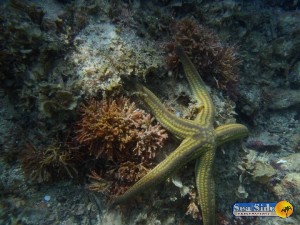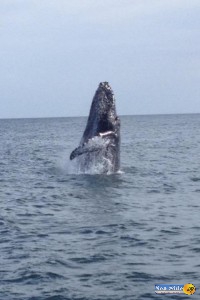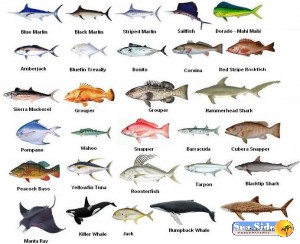By Steve Schwab
Fisherman often flock to Rocky Point, toss their gear in the boat and say: “Take me to the sharks!” It’s popular now, its exciting and its in style. I’m sure the Marlin population of Puerto Peñasco is quite relieved to learn that this oceanic predator has replaced them as the most sought after trophy fish. The Swordfish of the Sea of Cortez are also breathing a tenuous sigh of relief, getting bumped down the popularity scale while sharks of every size and species have become the object of fascination and speculation. While one marine species may be more popular than the other at times, the important thing to remember whether you are sport fishing in Puerto Peñasco or enjoying the experience of observing the sea creatures in their natural environment, is that there are still plenty of fish in the sea. In fact, there is a different marine species out there to suit every curiosity; from a blistering, wave riding battle, to a gently tugging delicacy lingering at the end of the line. Or, perhaps the slowly slithering crustaceans taking their time while seeking their next meal are more what you are looking for. The abundant marine life in Rocky Point provides both an excellent fishing experience and a rare opportunity to observe a vast variety of sea species up close.
From the sea to shore; what’s in store?
Visitors to Rocky point usually check in and drop their bags as quickly as possible before heading to the beach to peer into the clear water, to the creatures on the rocks, to the smooth sand and swimming fish. From the banks of Puerto Peñasco, gazing into the reefs and lagoons and tide pools, several species can be observed in their natural habitat. As the tide goes out, more species are revealed in the four tide zones; the first and most obvious are found in high tide (spray or splash zone). Here are observed several benign species that are exposed to the air 75-100% of the time. These species include buckshot barnacles, periwinkles and limpets. In zone two; (high intertidal or rockweed zone) reveals several species of crab and the turban snail. As the tide lowers to zone three (middle or midlittoral zone), hermit crabs, sea anemone and different varieties of starfish come to life. Zone four (lower intertidal zone) sees air less than 9% of the day and the sea life living there is mysterious and shy. Sea urchins, octopus and red abalone are now exposed, seeking shelter among the rocks and reefs while waiting for the water to return. Still below the water and cleverly camouflaged in the sand are Stingrays. Seaweed, surf palm and sea grass are also in abundance, depending on the tide.

Some of the marine life easily visible during low tide.
Where’s my fish?
Assuming you are still on the shore and the tide is safely back in zone one, you want to know what you’ll be able to catch just by fishing from the shore. Providing the seals and seagulls don’t steal your bait, cast out into the sea and prepare for a variety of species to show interest in your line. Late November is a popular time to hook Halibut from the shore, as well as Spotted Bay Bass and Leather Jackets. Although these are all still considered sport fish in the area, their usually smaller size makes them ideal for a leisurely day of shore fishing or just observing. Depending on the tides and seasons, other species can be encountered right from the shore, and often without live bait. Shortfin Corvina, Yellowtail and Black Skipjack frequent the waters near the shore depending on the temperature of the water. Some uninvited guests that may make a surprise visit include the poisonous Bullseye Puffer and the vile tasting Barracuda and Needlefish.
Sometimes, It’s what you can’t see…
From the slowly trolling fishing boats to the speeding sports vessels that abound in these waters, the marine life differs vastly, depending on the depth of the water and the distance from the shore. The marine life in the Sea of Cortez has often been considered the best location for the greatest variety of marine life. After nearly being fished out towards the late 1980’s, the marine life around Puerto Peñasco has rebounded and redoubled, becoming more resilient and plucky. At the same time, restrictions and protections imposed upon the waters of the area have directly led to the re-emergence of several vanishing marine species. Marine biologists also flock to the “world’s aquarium” much the way the fisherman do; to observe and record a vast variety of species that often requires the exploration of several geographical areas, but is concentrated here into a relatively small radius. Deep within the waters lurk the creatures of legend, intrigue and mystery. Sharks swim slowly and silently in the warm water, while the highly desired Sailfish and Marlin fly through the air at the end of the test line. Dolphins playfully swim in abundance, often racing with the fishing boats. Majestic Humpback whales burst through the water and splash to the surface, putting on a show for those in attendance.

A Humpback whale emerges from the water.
Far below the churning blades and watchful eyes lies a fascinating undersea world. Pink coral reefs and waving sea fans entice scuba divers and underwater explorers. Gliding through the depths, the massive, lumbering Manta Ray passes by while silvery schools of Green Jack swim in unison. Fearsome looking Moray Eels jut from rocks and coral. Whether you are observing the marine life from the surface; gazing into a tide pool as the earths rotation reveals new and different creatures with each rising or lowering level, or you are swimming and snorkeling among the creatures far below the surface of the water, Rocky Point and the Sea of Cortez provide the most sought after marine experience, deservedly hailed has the “Worlds Aquarium.”

Some of the Marine Species found in the Sea of Cortez


